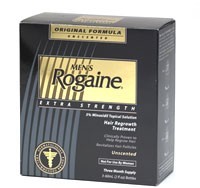Rogaine, Regaine or Minoxidil?

Rogaine was the first medicinal product in history approved by a major national health supervisory authority such as the FDA (the US Food and Drug Administration) to treat male pattern baldness. Now, generic Rogaine has been approved by the health authorities in many countries around the world. To this day it is the only FDA-approved topical for treating hair loss and the most powerful hair growth stimulant available. Rogaine and Regaine are exactly the same product with two different trade names, originally developed by Upjohn (later merged into Pfizer). Minoxidil is the main active substance of Rogaine and since it is no longer patent-protected, it can be found in numerous generic hair loss products. Minoxidil is typically used in concentrations of 5% for men and 2% for women. A few years ago Pfizer introduced Rogaine foam, a superior delivery form of minoxidil. Minoxidil containing topicals are available in pharmacies in most countries as non-prescription OTC products.
The frequently asked question of many hair loss sufferers is about the differences between various minoxidil-based topicals. The principal difference is in secondary ingredients not in minoxidil. These ingredients, in the first place, involve vehicles such as propylene glycol, ethanol and propanol. Secondly, numerous generic products combine minoxidil with various other active substances believed to further promote hair growth such as azelaic acid, retinoic acid, herbal extracts, etc. Pfizer's branded Rogaine/Regaine products only have minoxidil as their only active substance.
Translated into implications for the patient, one can say that the difference between various minoxidil containing products is mainly in the patient's tolerance of the product. Tolerance of minoxidil containing products is a frequently discussed topic as many patients have had to abandon treatment with minoxidil due to its side effects. The fact is that many side effects attributed to minoxidil are due to other substances contained in the product. The most frequent side effects are redness and an itchy, irritated scalp that are usually caused by a vehicle such as propylene glycol and/or propanol. This is often the beginning of a bigger problem. If treatment is not discontinued it can lead to increased absorption through the scalp and systemic overabsorption. This can result in more serious side effects, such as increased hair growth on other parts of the body, serious allergic reactions, very low blood pressure, irregular or fast heart beat, blurred vision, swelling or puffiness of hands, face and ankles, etc. For the new patient it is best advised to try several different types of minoxidil-based products to test their tolerability for your scalp. In general, Rogaine foam is the most suitable product for the majority of customers.